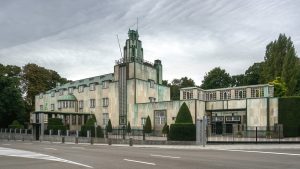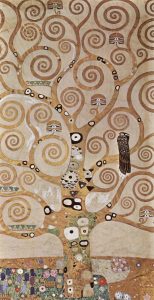Palais Stoclet : Brussels, Belgium : 1905-1911
Contributed by Kat Pence
Commissioned for banker and art enthusiast Adolphe Stoclet and his wife Suzanne Stoclet.
Designed by Josef Hoffman with an installation by Gustav Klimt.

Principles and Elements
As a blend of modernism and Art Deco, Palais Stoclet in Brussels, Belgium, boasts sleek lines, an unconventional floor plan, and a uniquely flat roof that contrasts the gables and mansards that were popular at the time. The structure repeats rectangle shapes in almost every aspect: the tiles on the exterior walls, the shape of the windows, the tower on top, the extensions on the side of the building, and the awnings. The color was kept muted, originally supposed to be black and white, but over time the copper in the roof patinad, giving the tower a green hue as well as the walls as the copper was washed down them.

Palais Stoclet Tower, Photo by Fred Romero, CC BY 2.0
Connections Across Scale
The tower on top of the roof is adorned with metal flowers, patterns engraved within the trim, and four identical statues of men. The oxidation of the bronze has turned this part of the building almost completely green, reminiscent of The Statue of Liberty’s patina. Originally, the colors of the building would have been striking bronze, black, and light gray, but time has replaced that copper with green, almost creating a new design entirely as the building aged. Hoffman designed Palais Stoclet to be all encompassing, making the landscaping, furniture, and architecture all a part of the design. The flowers and engravings within the tower tie the manicured landscaping in with the structure itself, and the statues of men emphasize this buildings intent to be lived in, and show off the massive scale of the palace.

Palais Stoclet Facade Detail, Photo by Fred Romero, CC BY 2.0
Materials
Constructed over a long period of 6 years, the palace is built from brick with concrete and granite facades. The inside is lavishly adorned with white marbles and black granite all the way from Norway that tie in the heavy color contrast on the outside with the interior. Glass is heavily used as each wall is adorned with many windows. Materials that cannot be overlooked are the hedges and plants that surround the building, which are specifically manicured to extend the design from the building itself into the geometric gardens. Finally and most iconically, the bronze and copper that make up the statues, the roof, and the trim that covers the exterior corners. The use of this material provided striking contrast then, and a different striking contrast now as it has all oxidized into Lady Liberty green.

Mosaic frieze design by Gustav Klimt (Museum of Applied Arts, Vienna). Image in the Public Domain
Light and Color
While the original construction would have been black, white, and bronze, today the most striking of the colors present is the green that covers every element that originally boasted the copper. Placed against a back drop of forest green hedges and trees, the building almost feels more natural, as the materials have reacted with the past hundred years of sun and elemental exposure. Natural lighting was an important factor to Hoffman in this design, with just about every wall repeating white rectangular windows that allow plenty of sun in. With the interior as imposing as it is with the high ceilings and intense marble/granite adornments, natural light is important to make the palace feel more like a home. Gustav Klimt’s polychromatic frieze panels provided additional color on the interior.

Elevation and plan drawings. Image by Daniel Base, CC BY-SA 3.0
Experience
The experience of Palais Stoclet begins before you even set foot within its fences as you see the 20 meter high tower. It doesn’t end even as you enter the gardens which are meticulously maintained to protect the shapes that furnish the outdoors. The expensive interior provides an experience of luxury, and the many areas that are surrounded entirely by windows allows the user to experience plenty of sunlight without setting foot outdoors.

Line drawing by chapter author.
Technology
In 1905, running water and indoor plumbing were still not standard within houses and were a status symbol. The bathroom boasting a large marble tub with a shower and a double sink is a display of wealth and a technological innovation that would become commonplace over the next few decades. The bathroom is large enough to adorn with chaises and side tables that creates a living space in and of itself.

Tree of life detail, Image in the Public Domain.
Finishes
Architect Josef Hoffman was a major player in the Vienna Secession, an art movement that rebelled against traditional art styles in Austria. The most well known artist of this movement was Gustav Klimt, a friend of Hoffman and a painter famous for gold leaf, abstract shapes, and feminine and often sensual subject matter. It is only fitting that in a palace as extravagant as Palais Stoclet, that a gold leaf installation by a famed painter would be included in the design of the dining room. Klimt’s work mirrors itself on two opposing walls in the dining room, the gold leaf matching the gold embellishments of the dining furniture and contrasting the black and white checkered floor.
Palais Stoclet Dining Room, Photographer unknown. Photo in the Public Domain
Furnishings
Furnishings throughout the palace are rectangular in nature, a signature of Hoffman’s style. They often construct rooms with a room which makes such a large space feel cozier. The dining room is evidence of this as the rectangular backs of the chairs form almost a wall around the table. The floor’s design works in conjunction to make the dining table feel more intimate, while still being an expression of the owner’s wealth. Interestingly, while most dining tables only have one chair at each head, this one has two which may promote a more egalitarian view of dinner rituals and is another example of the rebellion against convention promoted by this art movement.

Postcard of Palais Stoclet and Avenue de Tervueren in Brussels, just before 1914. Stamped in 1923. Image in the Public Domain
Telling Stories
The stories told within Palais Stoclet are that of wealth and extravagance, but also rebellion and exploration. Traditional elements combine with new to make the house feel familiar and unfamiliar at the same time. Familiar are the expensive carpets, marbles, and gold, unfamiliar are the sleek shapes, rectangular emphasis, and heavy use of glass. The story told is one of a wealthy owner who wanted to display his fortune prominently, but also wanted to show that he was embracing the changing times.

Line drawing by chapter author.
Theories
Architect Josef Hoffman was known for his emphasis on geometry, specifically cubic forms. This is represented in most of his work, but is clear in Palais Stoclet. The salon above is geometrically precise, the furniture creating a square room within a room and each chair creating its own room with the high and uniform arm and back rests. In addition to the many rectangular shapes, the finishes match colors perfectly, with copper colored granite columns that continue his rectangular designs. Palais Stoclet is often regarded as one of the first examples of Art Deco, a design style that would dominate the Roaring 20s. As a principle member of the Vienna Secession art movement, Hoffman set out to design luxury that transcended expectations and the status quo. His geometric emphasis and theories of an all encompassing design would help to lay the groundwork for the architecture of the modernism movement to emerge.
References
Centre, U. W. H. (2009). Stoclet House. UNESCO World Heritage Centre.
Stoclet Palace – Data, Photos & Plans. (n.d.). WikiArquitectura. Retrieved February 23, 2024.
Betsky, A. (2018, October 4). The Palais Stoclet Seduces. Architect Magazine.
